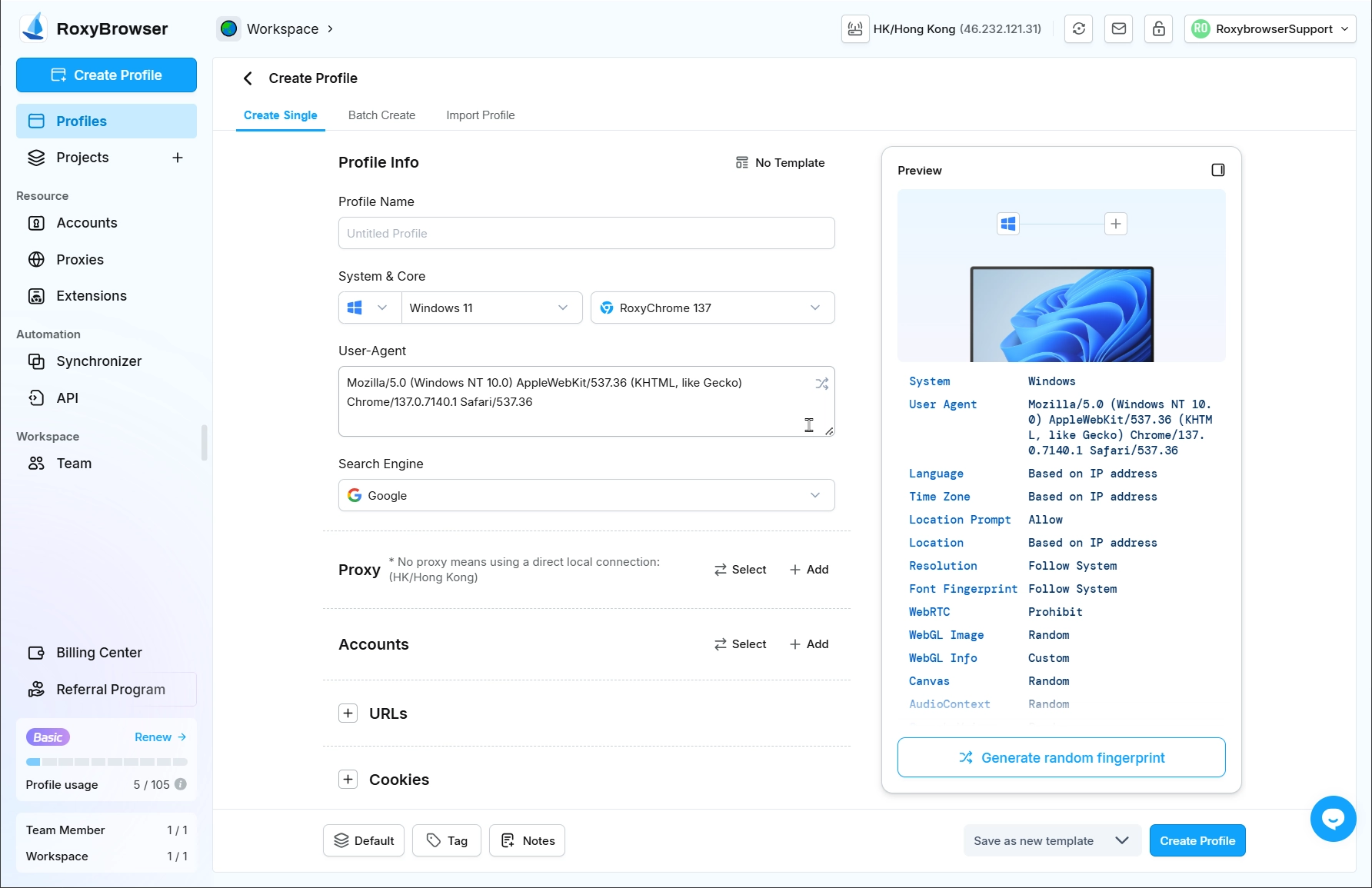Advanced Fingerprint
User Agent
The User Agent is the primary method websites use to obtain browser information. Through the User Agent, websites identify your browser type, version, operating system, and other critical details, making it a core component of browser fingerprinting.
Like all HTTP request headers, the User-Agent string is one of the identifiers sent by the client to the server. Since User-Agents vary significantly across devices and browsers, RoxyBrowser employs intelligent algorithms to dynamically generate randomized User-Agents that match real device characteristics, ensuring each browser environment has a credible and unique identity.
For example, a Chrome browser's User Agent on a Windows PC:
Mozilla/5.0 (Windows NT 10.0) AppleWebKit/537.36 (KHTML, like Gecko) Chrome/135.0.7039.0 Safari/537.36
| String | Description |
|---|---|
| Mozilla/5.0 | A universal compatibility token indicating Mozilla compliance—standard for modern web browsers. |
| (Windows NT 10.0) | Windows NT is the core technology name; 10.0 is the internal version number for Windows 10/11 (shared kernel version). |
| AppleWebKit/537.36 | The browser's rendering platform (WebKit engine), where 537.36 denotes the version. |
| (KHTML, like Gecko) | Platform details (KHTML renderer, Gecko-compatible) for website compatibility. |
| Chrome/135.0.7039.0 | Indicates Chrome browser with version 135.0.7039.0. |
| Safari/537.36 | Safari compatibility marker. |
| Mobile (if present) | Identifies mobile device usage. |
Cookies
HTTP cookies address the stateless nature of the HTTP protocol (where servers lack user context). Websites use cookies to store session states, login credentials, behavioral data, etc., making them a core vector for identity tracking and persistent fingerprinting.
Common cookie use cases:
Session persistence: Avoids repeated logins on page refreshes.
Shopping cart retention: Preserves cart contents post-browser restart.
Personalized content: Enhances UX by reducing repetitive searches (privacy concerns: long-term tracking for targeted ads).
Form autofill: Minimizes manual input.
How to access cookies?
In Chrome, press F12 > Developer Tools > "Application" tab (Chrome/Edge) or "Storage" (Firefox) > "Cookies" to view all cookies for the current site.
WebRTC
WebRTC enables powerful real-time communication but may leak IP addresses.
Primary use: Direct browser-to-browser audio/video/file transfers (e.g., Zoom web, Discord voice).
Risk: Exposes local IPs even with VPNs/proxies. Disabled by default—only enable if required, as it compromises fingerprint authenticity.
WebGL & WebGPU
WebGL: A mature web graphics technology for hardware-accelerated 2D/3D rendering without plugins, widely used in online games, data viz, and VR.
WebGPU: The next-gen graphics API, enhancing WebGL's performance and capabilities.
These APIs expose hardware details (GPU model, driver version, rendering specs) for fingerprinting.
WebGL Image
Real: Uses actual hardware data.
Random: Generates virtual parameters algorithmically (default).
WebGL Info
Real: Returns true device specs.
Custom: Manual/randomized params (default). Use Randomize for quick config swaps.

WebGPU
WebGL-matched (default; maintains consistency for fingerprint realism).
Real: True device data.
Disabled: Blocks WebGPU.
Canvas
HTML5's Canvas dynamically renders graphics, but device-specific rendering quirks (hardware/drivers/engine) create unique fingerprints.
Random: Algorithm-generated params (default).
Real: Native rendering output.
AudioContext
The Web Audio API for sound processing. Device-specific audio hardware/driver variations let sites analyze test signals to generate high-precision fingerprints.
Random: Algorithmic params (default).
Real: Actual audio processing results.
Speech Voices
Web Speech API's voice synthesis. Sites query supported voices (language/speaker/timbre) for unique fingerprints—highly variable across OSes/browsers/language packs.
Random: Virtual voice list (default).
Real: Native voice list.
Do Not Track
A privacy feature signaling "Do Not Track" via HTTP headers (DNT: 1), though sometimes used as a fingerprint component.
On: Sends DNT: 1 (default).
Off: Allows tracking.
Client Rects
API for precise element layout data (position/size). Rendering differences across devices/browsers/fonts create unique fingerprints.
Random: Algorithmic params (default).
Real: Native rendering data.
